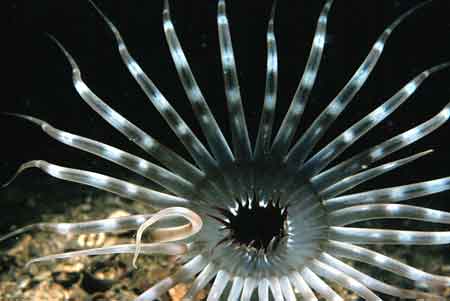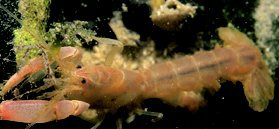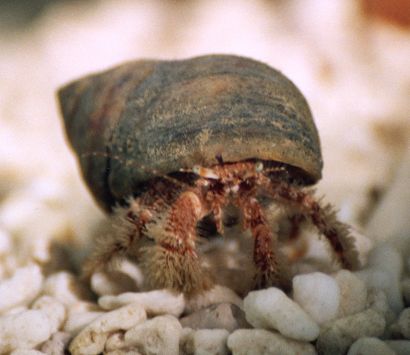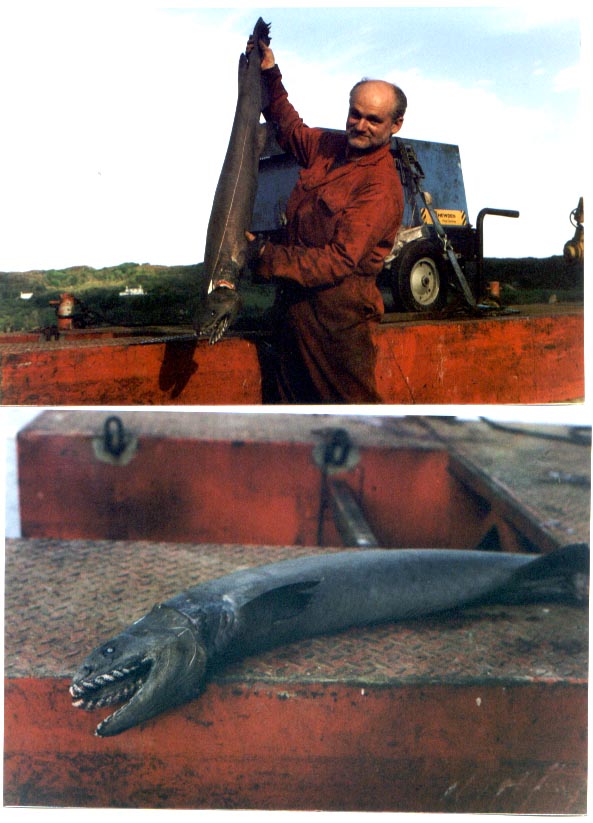
|
Homepage |
|
|
|
|
|
|
|
|
|
|
|
Membership Page |
|
|
|
|
|
|
|
|
GLAUCUS HOUSE : 14 CORBYN CRESCENT : SHOREHAM-BY-SEA SUSSEX : BN43 6PQ
TEL: 01273 465433 Email messages to:

EMail Glaucus@hotmail.com
|
|
|
|
Unidentified Shark reported by Bill Chadwick (November 2000)

Can
you identify this sea anemone.
The
photograph was taken by Jim Anderson
in the Sound of Jura.
Jim
Anderson's Scottish nudibranch pages (Link)
Dear Andy,
The image you sent is quite a nice one. While internal examination is required to positively identify a cerianthid, I would say that the depth and the number of marginal tentacles (and the markings on them) do coincide with the description and picture provided by Picton & Manuel (1985). Although the colouration of tentacles and oral disc in the picture provided has not previously been described for A. sarsi, species can exhibit a wide degree of variation in this regard.
It is interesting to note from Jim's message that this is the only sighting in the area from 13 years of diving there. I regularly dive a shallow maerl site in the west of Ireland on which a population of Cerianthus lloydii resides. Yet every time I dive, it takes a couple of minutes for me to distinguish the animals from their background even though I know they're there - if only they were all as distinct as Pachycerianthus multiplicatus!
Best wishes,
Eamonn
************************************************************************
Dr. Eamonn Kelly
Department of Zoology,
Martin Ryan Marine Science Institute,
National University of Ireland, Galway,
Republic of Ireland.
Mail eamonn.kelly@nuigalway.ie (changing soon)
Cerianthidae and Pachycerianthus multiplicatus
I've just finished my PhD on adult Cerianthidae and Pachycerianthus multiplicatus in particular but still have an interest in these animals.
For wildlife reports of these anthozoans go to the News 2000 page (click on this text).
Do you have any further info about these observations? For example, were they made at night or during the day (I have a theory that the reason Arachnanthus sarsi is so rarely observed generally is because it is a nocturnal species), did they occur on hard or soft ground, and were they located in a high or low flow regime?
Due to the lack of research in this area, dealing with these animals is like putting a jigsaw together-it's the little pieces of information that contribute to the bigger picture.
Keep up the good work,
Eamonn Kelly
EMail: eamonn.kelly@nuigalway.ie
Can you positively recognise this small spider crab to species level, found by Robert Jones (Trowbridge), on the shore of Dorset (English Channel)?

English Channel Crustacean
 Do
you recognise this crustacean, washed up on the shores at both Pevensey
(this picture) by Evan Jones and at Brighton by
Andy
Horton. This animal has also been recorded by the late John Barker
from Shoreham (Kingston Beach). The animal was
washed up after a period of depositing waves and winds when a lot of silt
covered the lower shore where the Brighton crustacean was discovered under
a small rock at a low spring tide (zone:
infralittoral
fringe). The small crustacean, about 40 mm long, including the claws,
can make a snapping sound like breaking glass (one record only).
Do
you recognise this crustacean, washed up on the shores at both Pevensey
(this picture) by Evan Jones and at Brighton by
Andy
Horton. This animal has also been recorded by the late John Barker
from Shoreham (Kingston Beach). The animal was
washed up after a period of depositing waves and winds when a lot of silt
covered the lower shore where the Brighton crustacean was discovered under
a small rock at a low spring tide (zone:
infralittoral
fringe). The small crustacean, about 40 mm long, including the claws,
can make a snapping sound like breaking glass (one record only).
Hi folksSEA ADDERS
I quote from the Cornishman (4th May, 2000) in their yesteryear column from
100 years ago."On Friday morning a number of sea-adders were seen swimming about the
harbour, they were of pink colour and measured about eight inches in length.
Several were captured by the fisher boys."What is a sea-adder?
John Worth
What fish or other animal do you know as Sea Adders ? (British Isles only)
From: "John" <johnworth@worth20.freeserve.co.uk>
Subject: Sea-adders

Hairy Hermit Crab from the shore at Bembridge, Isle of Wight, England.
Can anybody identify the species?
Other Hermit Crabs (Link)
Hermit Crabs for the younger reader
Whelk Egg massSome interesting whelk info on the BMLSS page, but I'm still puzzling over how the hatched whelks got out of the unpunctured cases! The site suggested that if I went diving I could see the eggs being laid, but as I don't dive, maybe someone could tell me ... how long does it take a whelk to lay a pile of egg cases and eggs, and is the case made of slime or is it also laid?
Robin ParisI cannot answer your question from memory. It is just possible that I have some notes somewhere (not on my current computer) but I have not watched the whelks egg laying, and I do not know anybody who has. I have seen the cases underwater.
EMail: robin@robinparis.freeserve.co.ukI quite often look in egg cases found between the tides for any animals sheltering inside. I have found small sea slugs Elysia this way.
reply by Andy Horton
|
http://www.austmus.gov.au/seaslugs/ |
|
|
|
|
|
includes the Cnidarian Forum |
| FIVE
KINGDOMS TAXONOMIC INDEX TO BRITISH MARINE WILDLIFE
Use these links if your are familiar with the scientific classifications of marine life |
The BMLSS (England) site commenced on 1 January 1997
|
|
|
 EMail EMail |
|
|
|
|
|
News 2018 |
Membership Form |
|
Andy Horton, Webmaster
Copyright © 2000 British Marine Life Study Society
Permission has NOT been granted for the craft and intellectual work on this site to be lifted and placed on a different web site or other publications. However, a Link to this site is permitted, and welcomed, on your own web site pages. If you have included a Link to this site, please advise. If it is relevant, a reciprocal link may be included.
|
|
